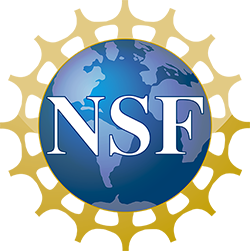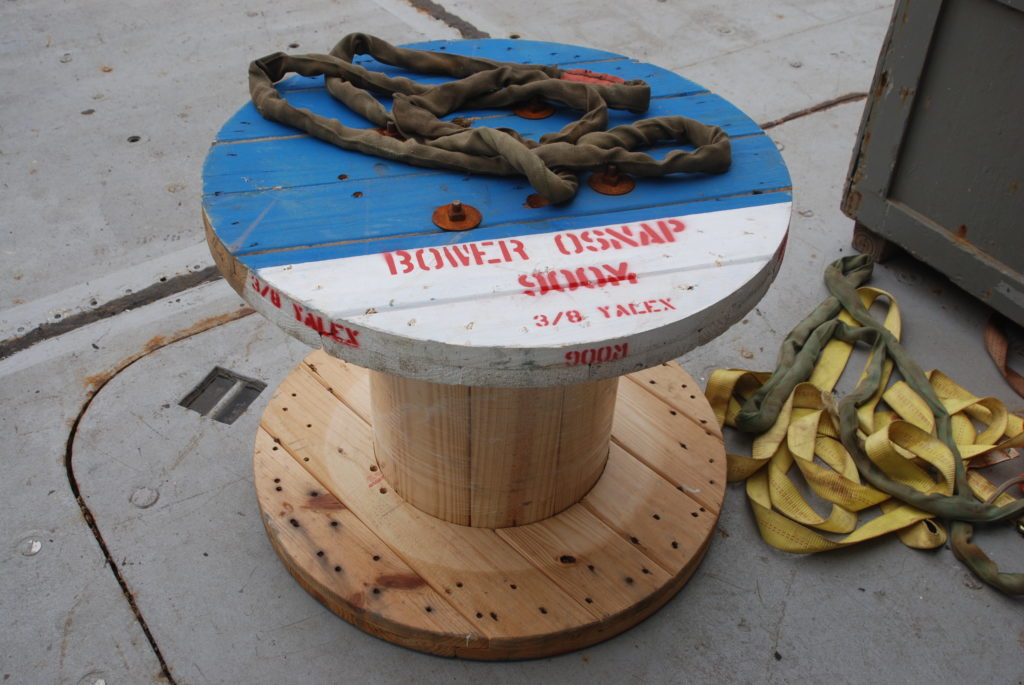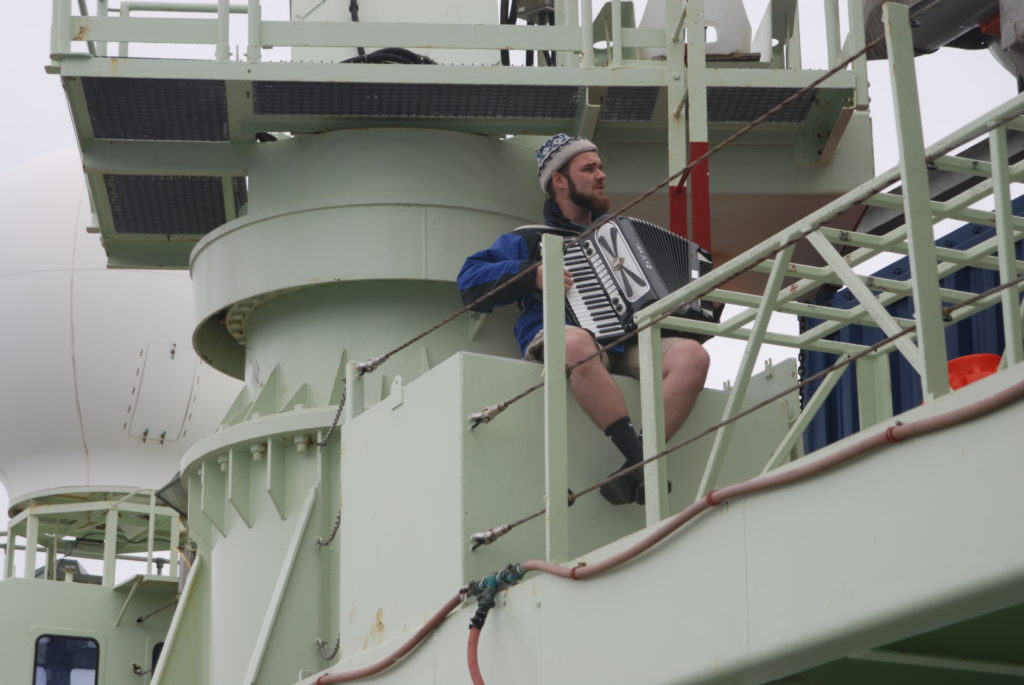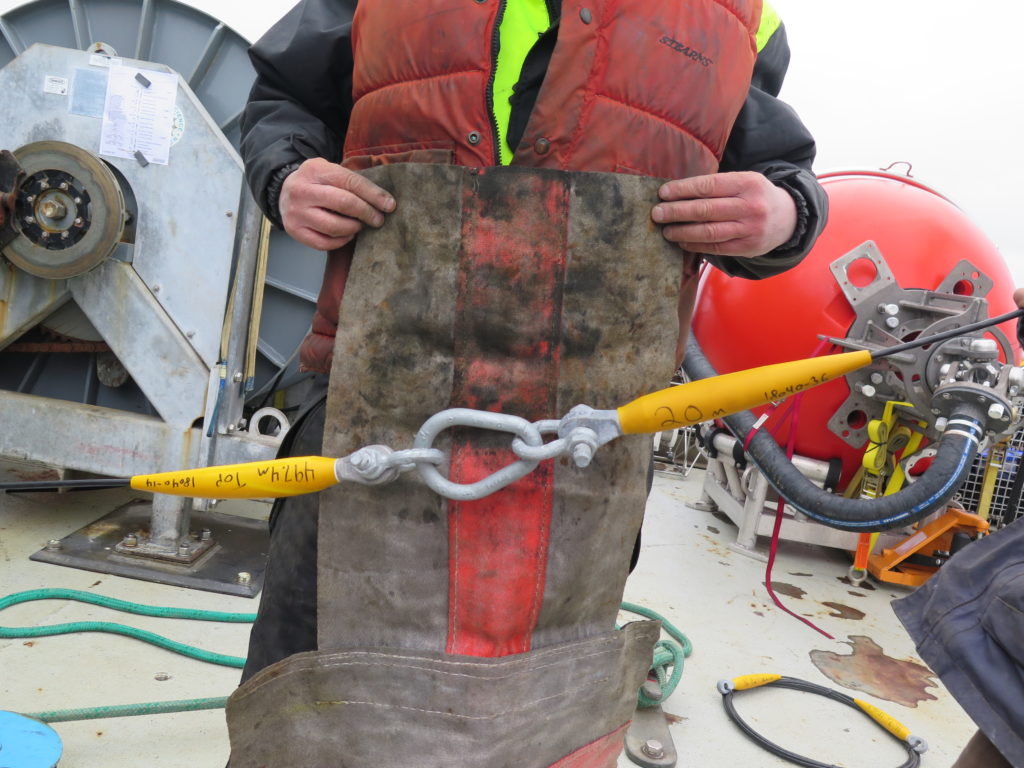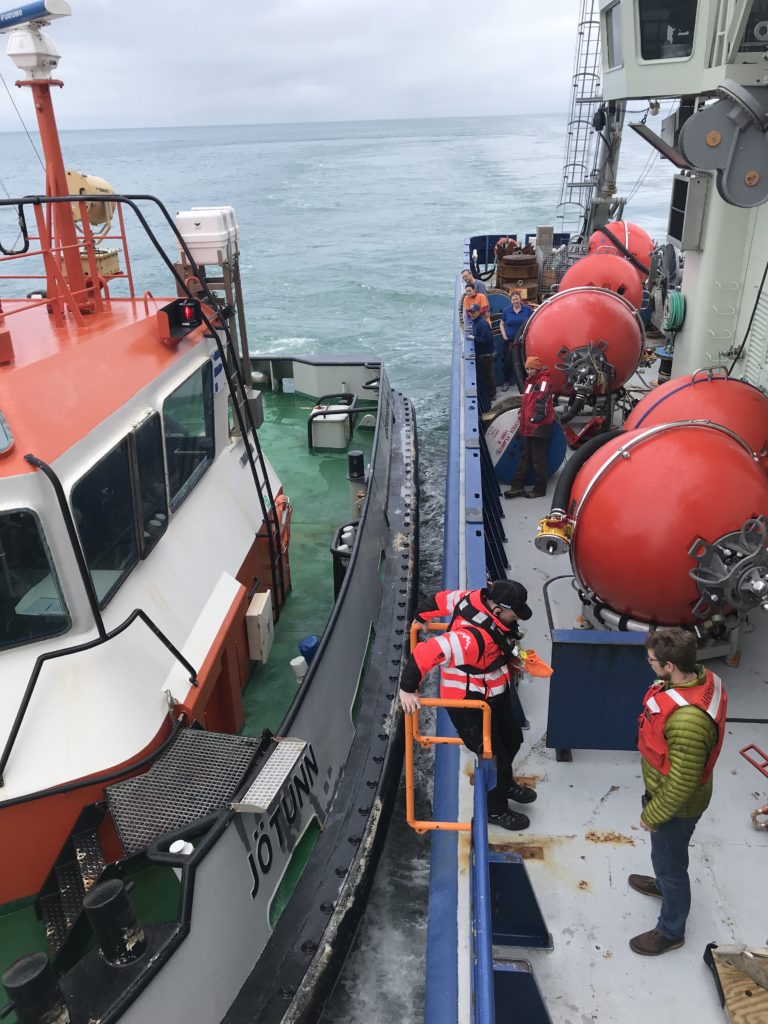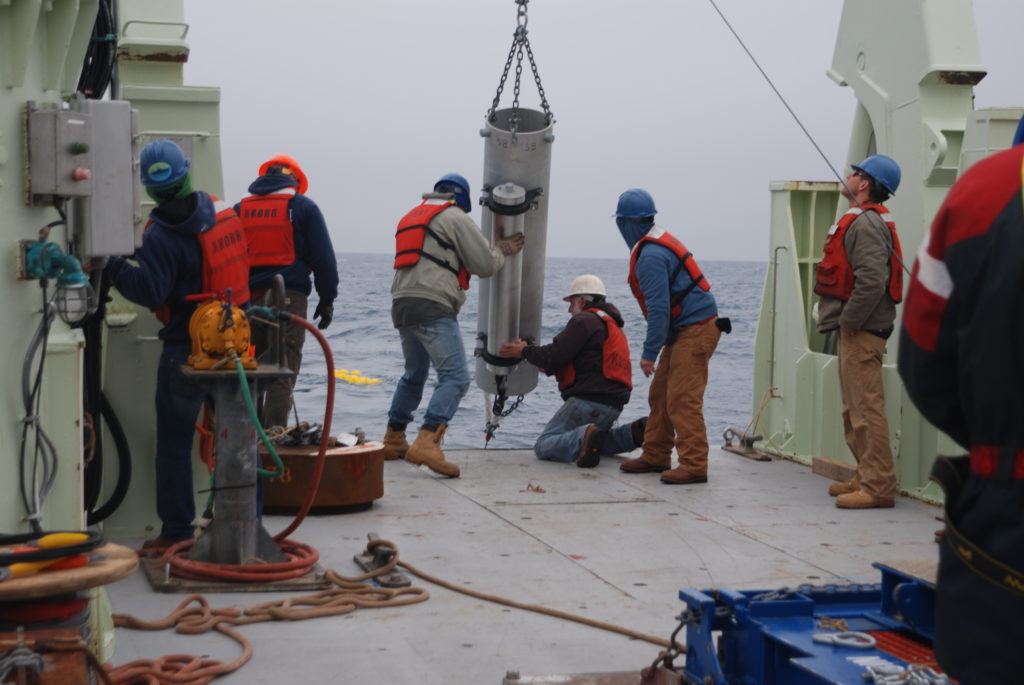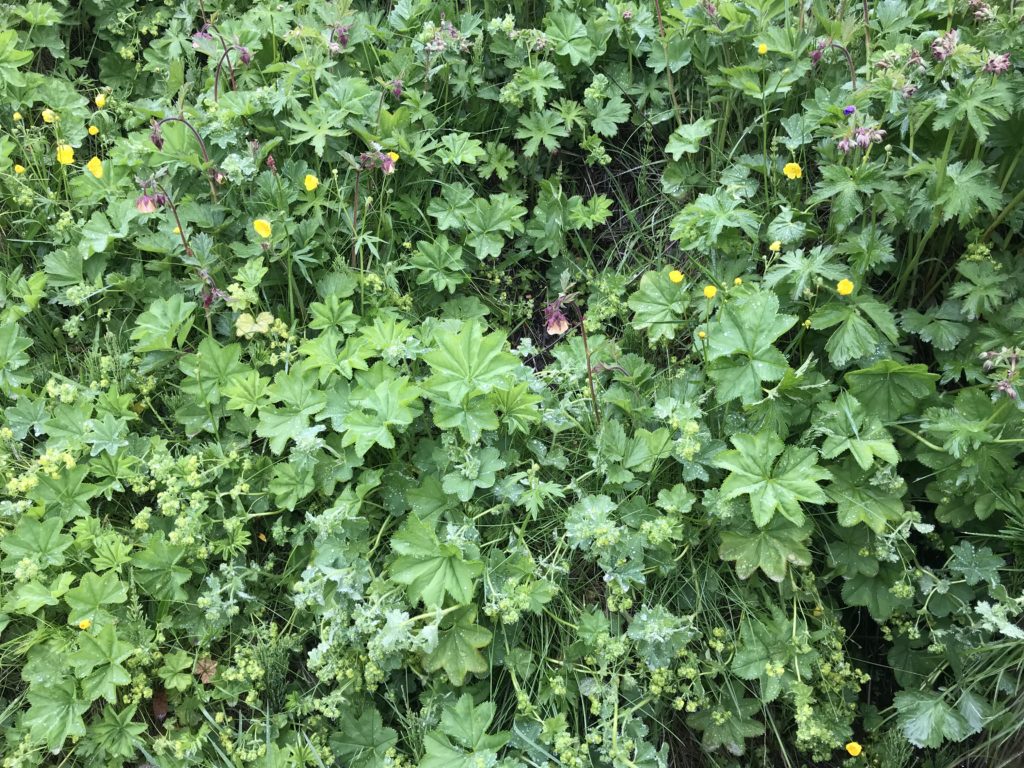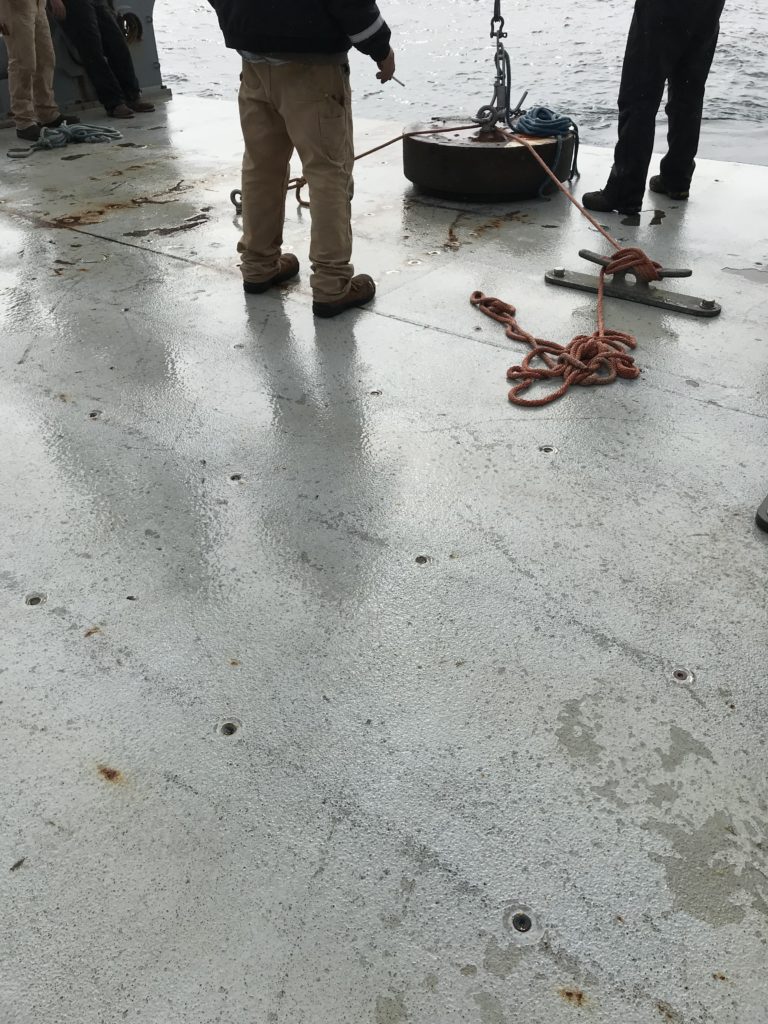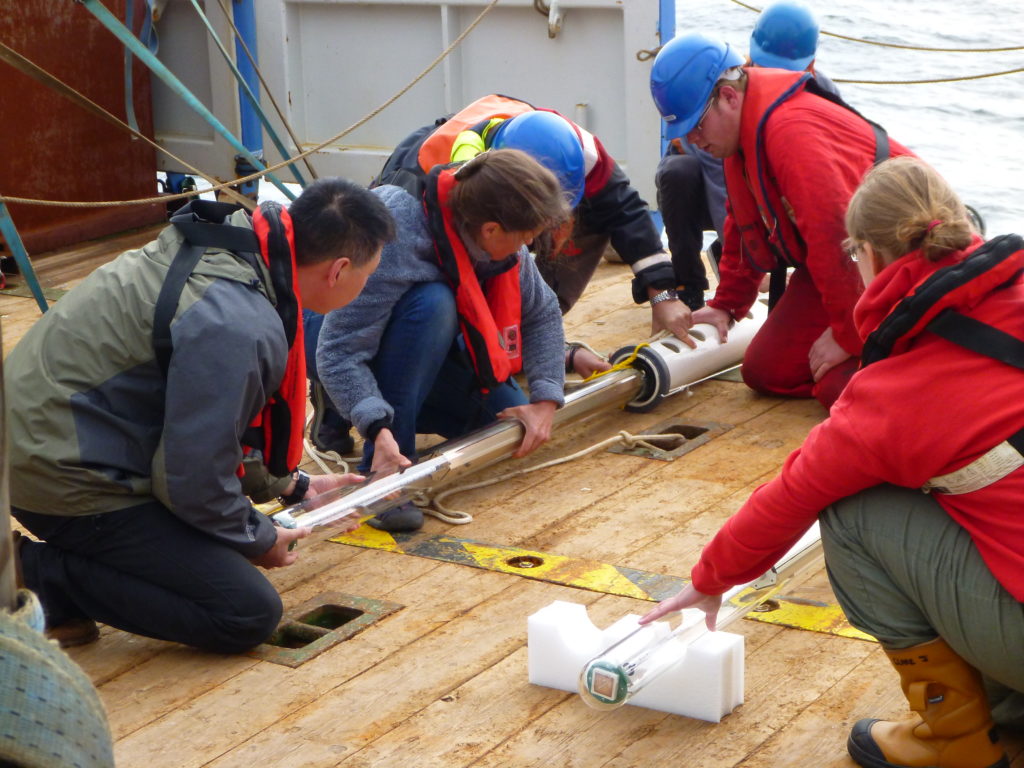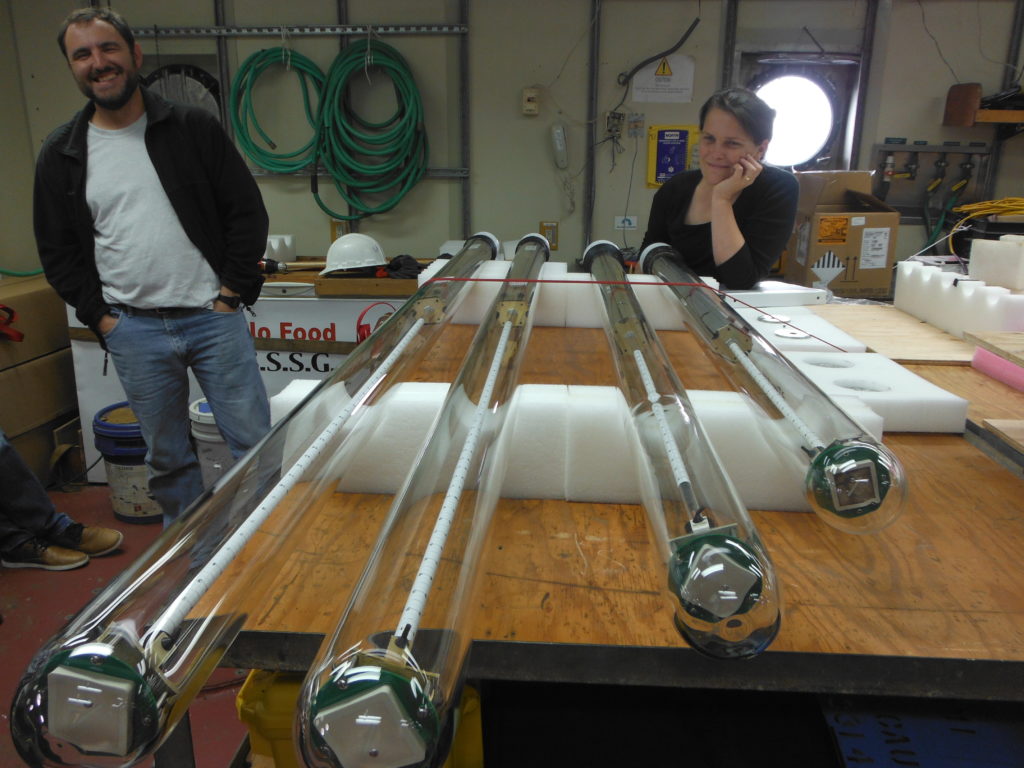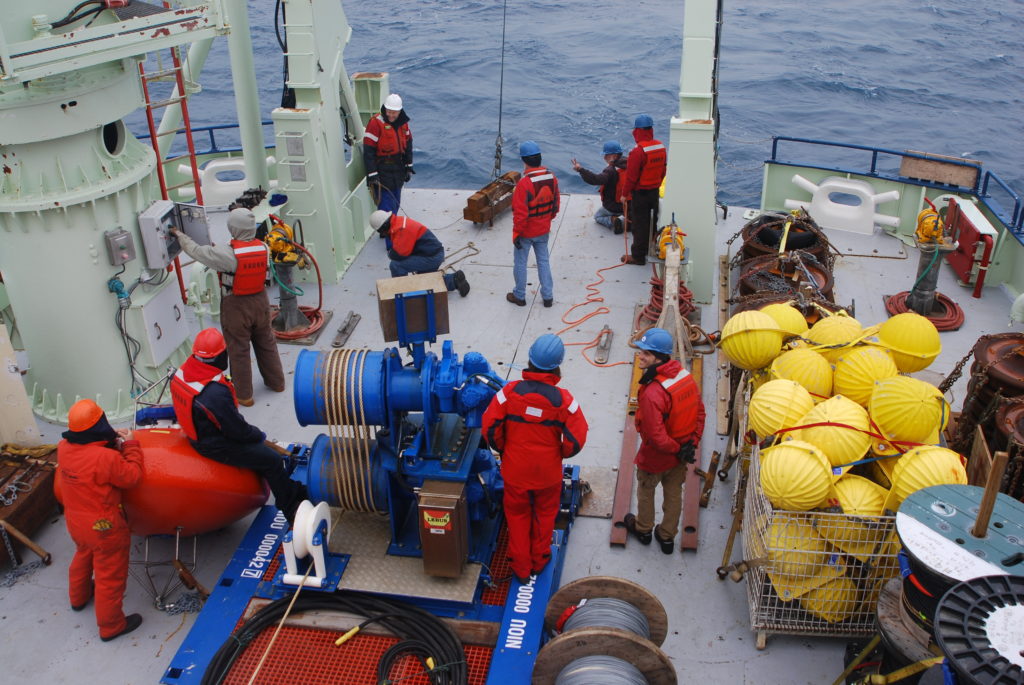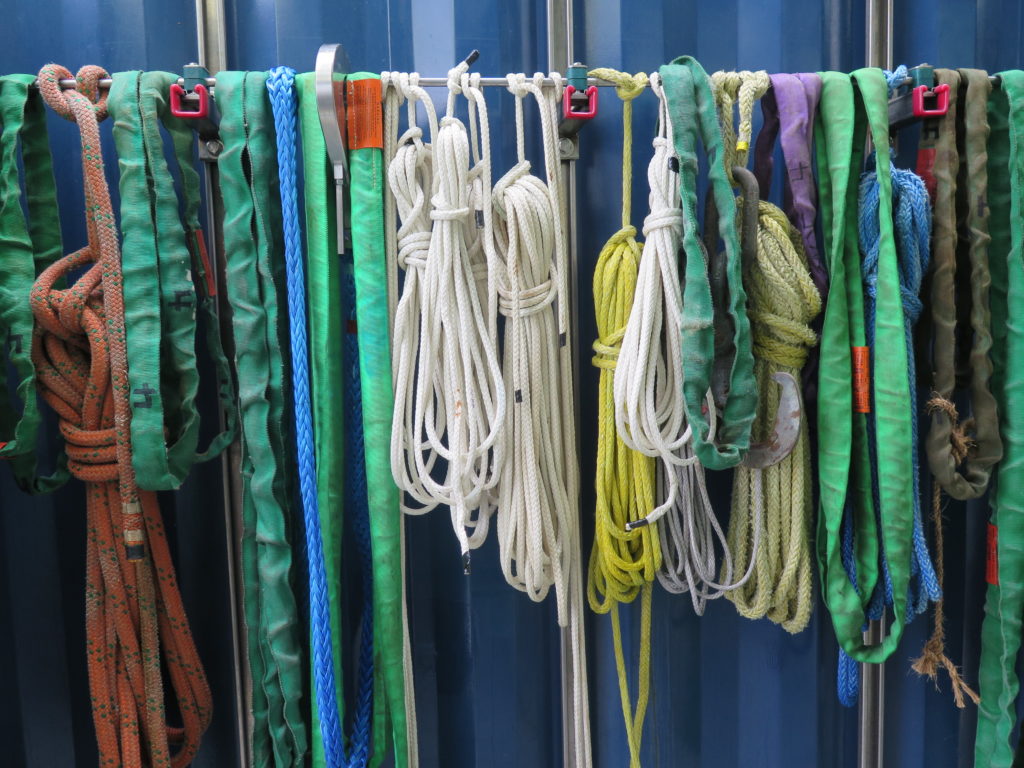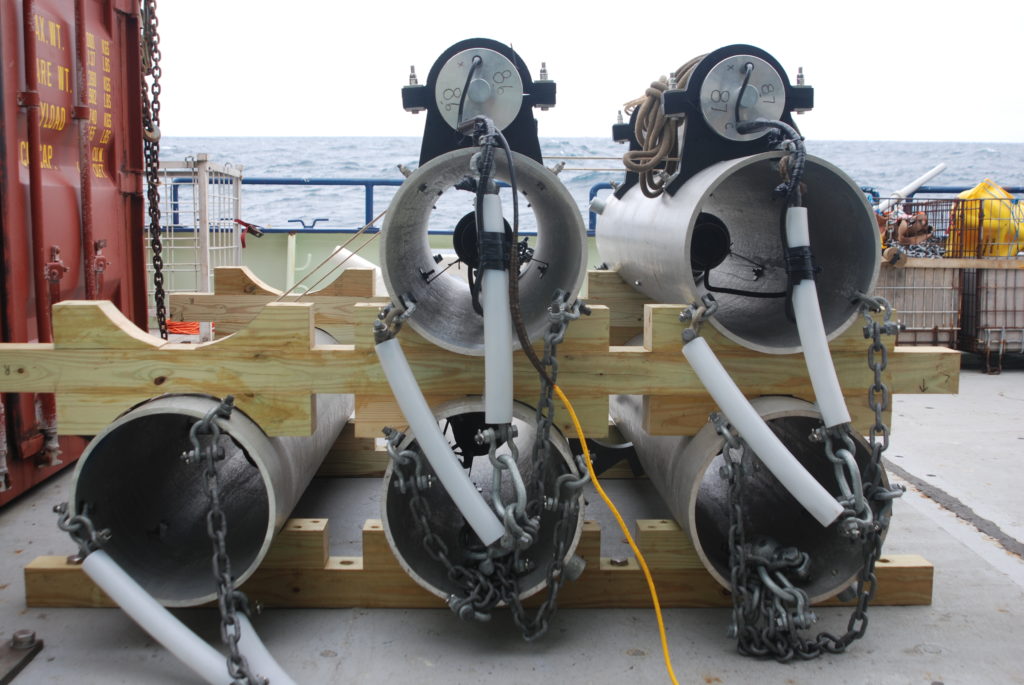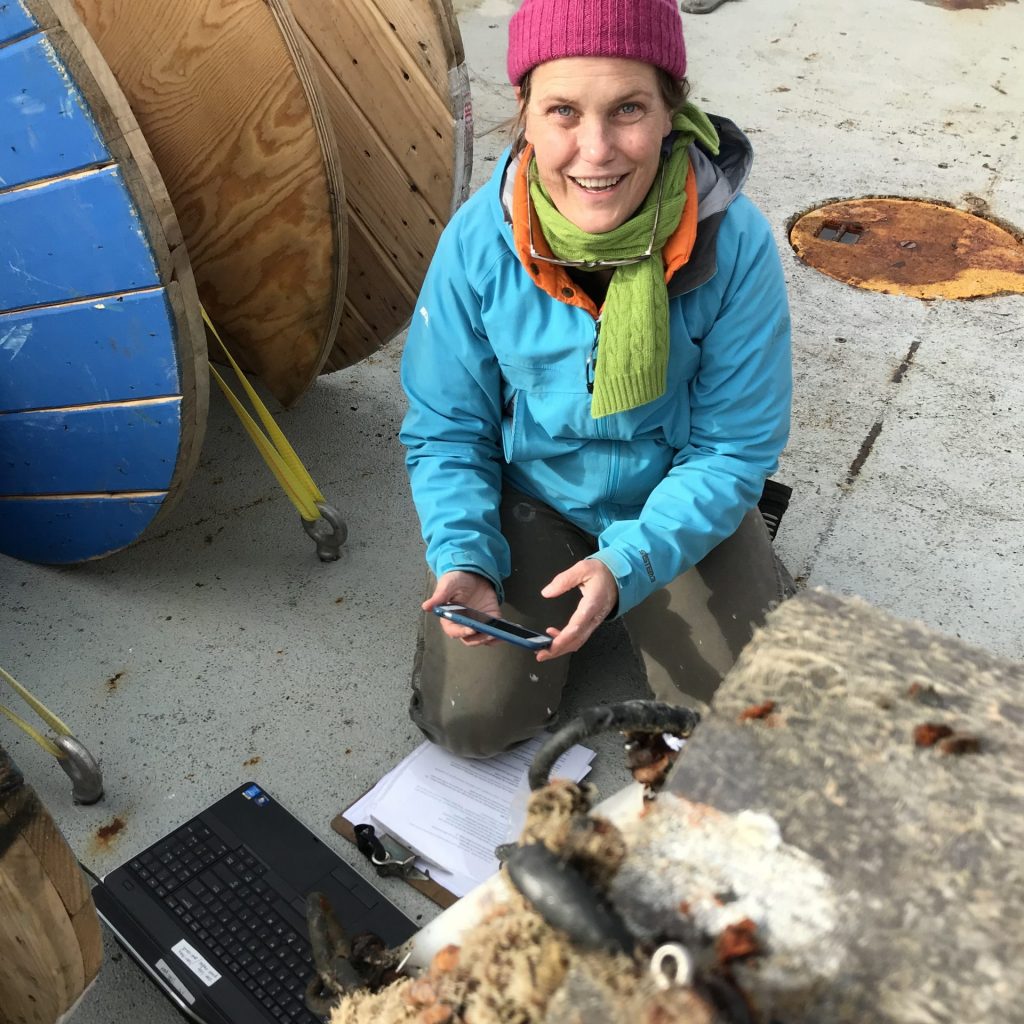OSNAP: Overturning in the Subpolar North Atlantic
OSNAP is an international program designed to provide a continuous record of the full-water column, trans-basin fluxes of heat, mass and freshwater in the subpolar North Atlantic. The OSNAP observing system consists of two legs: one extending from southern Labrador to the southwestern tip of Greenland across the mouth of the Labrador Sea (OSNAP West), and the second from the southeastern tip of Greenland to Scotland (OSNAP East).
The observing system also includes subsurface floats (OSNAP Floats) in order to trace the pathways of overflow waters in the basin and to assess the connectivity of currents crossing the OSNAP line.
OSNAP: Floats
Deep RAFOS floats were used to track the pathways of the lower limb of the overturning circulation through the subpolar North Atlantic. These passive drifters were ballasted to drift at depths ranging from 1800 to 2800 meters, and deployed in the deep boundary currents: along the western side of the Reykjanes Ridge in the Iceland Basin, Read More
OSNAP: Moorings
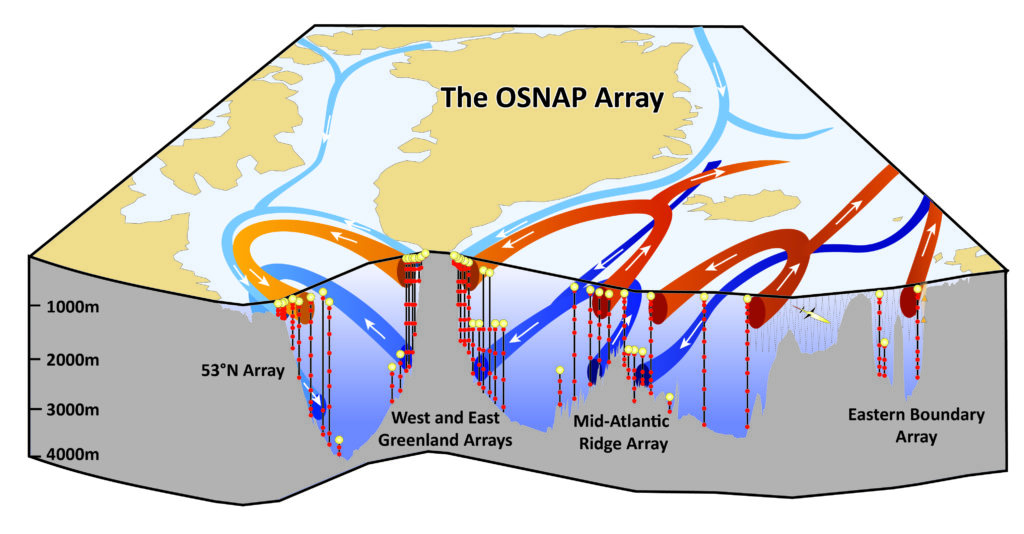 The Bower Lab is responsible for the Greenland Deep Boundary Current mooring array located offshore of the shelf break east of Greenland, bracketing the OOI Irminger Node.
The Bower Lab is responsible for the Greenland Deep Boundary Current mooring array located offshore of the shelf break east of Greenland, bracketing the OOI Irminger Node.
OSNAP: Gliders

A WHOI-OUC collaboration took place from 2014-2016 where TWR gliders were deployed and maintained west of the Rockall Plateau along the OSNAP line. The glider array was used to measure the highly variable branch of the NAC which travels over the Charlie-Gibbs Fracture Zone and continues into the Iceland Basin, meandering northward towards the Iceland-Scotland sill.
Data access
Greenland Deep Western Boundary Current Mooring data are available at OSNAP Data.
Dataset: Bower, A., Straneo, F. Furey, H., Biló, T., Bahr, F. "Overturning in the Subpolar North Atlantic Program (OSNAP) moored current meter, temperature, conductivity, salinity and pressure data collected on subsurface moorings M1, M2, M3 and M4 between June 2018 and August 2020." 2023-06. DOI:10.26025/1912/66314
Dataset: Houk, A., Bower, A. "Greenland Deep Western Boundary Current (GDWBC) Mooring Data 2020-2022." 2024-05. DOI: 10.26025/1912/69370
Publications
Koman, G., A. Bower, P. Holiday, H. Furey, Y. Fu, and T. Bilo, 2024. Decreasing transport of the Deep Western Boundary Current in the subpolar Atlantic. Nature Geosciences, submitted.
Furey, H., Houk A., and Yoder, M., 2024. AR8401_Cruise Report_OSNAP_GDWBC_2024 WHOI Cruise Report, 96 pp.
Furey, H., Bower, A., Ramsey, A., Houk, A., & Meunier, T. (2024). Variability of Iceland Scotland Overflow Water Across the Reykjanes Ridge: 2‐Years of Moored Observations in the Bight Fracture Zone. Journal of Geophysical Research: Oceans, 129(6), e2023JC020463. doi:10.1029/2023JC020463
Furey, H., N. Foukal, A. Anderson, and A. Bower, 2023. Investigation of the source of Iceland Basin freshening: virtual particle tracking with satellite-derived geostrophic surface velocities. Remote Sensing, https://doi.org/10.3390/rs15245711.
Bower, A., J. Vazquez-Cuervo, and E. Comstock, 2024. Navigating a sea of obstacles: Ocean science for people with disabilities. Oceanography, 36(4), doi.org/10.5670/oceanog.2024.106.
Koman, G., M.C. Curran, A.L. Ramsey, A.S. Bower, and H.H. Furey, 2023. Listening to the ocean: using data sonification to teach students about the role of ocean circulation in climate change. Science Activities, https://doi.org/10.1080/00368121.2023.2236047.
Fu, Y., M.S. Lozier, T.C. Bilo, A.S. Bower, S.A. Cunningham, F. Cyr, M.F. de Jong, B. deYoung, L. Drysdale, N. Fraser, N. Fried, H.H. Furey, G. Han, P. Handmann, N.P. Holliday, J. Holte, M.E. Inall, W.E. Johns, S. Jones, J. Karstensen, F. Li, A. Pacini, R.S. Pickart, D. Rayner, F. Straneo, and I. Yashayaev, 2023. Seasonality of the meridional overturning circulation in the subpolar North Atlantic. Communications Earth & Environment,https://doi.org/10.1038/s43247-023-00848-9.
Zou, S., A. Bower, S. Lozier, and H. Furey, 2023. Deep ocean circulation in the subpolar North Atlantic observed by acoustically-tracked floats. Progress in Oceanography, (2023): 102975. doi.org/10.1016/j.pocean.2023.102975.
Furey, H., E. Park, and A. Houk, 2022. AR6901_Cruise Report_OSNAP_GDWBC_2022 WHOI Cruise Report, 160 pp.
Lozier, M. Susan, A.S. Bower, H.H. Furey, K.L. Drouin, X. Xu, and S. Zou, 2022. Overflow water pathways in the North Atlantic. Progress in Oceanography, V208, doi.org/10.1016/j.pocean.2022.102874
Zou, S., Bower, A.S., Furey, H., Pickart, R.S., Houpert, L. and Holliday, N.P., 2021. Observed Deep Cyclonic Eddies around Southern Greenland. Journal of Physical Oceanography, 51(10), pp.3235-3252. doi.org/10.1175/JPO-D-20-0288.1
Valdes, J., and H. Furey, 2021. WHOI 260Hz Sound Source - Tuning and Assembly. Woods Hole Oceanographic Institution Technical Report, WHOI-2021-02, 65 pp. doi: 10.1575/1912/27173
Ramsey, A., H. Furey, and A. Bower, 2020. Overturning of the Subpolar North Atlantic Program (OSNAP): RAFOS Float Data Report, June 2014 - January 2019.Woods Hole Oceanographic Institution Technical Report, WHOI-2020-06; doi:10.1575/1912/26515.
Zou, S., A. Bower, H. Furey, S. Lozier, and X. Xu, 2020. Redrawing the Iceland-Scotland Overflow Water Pathways in the North Atlantic. Nature Communications, 11(1), pp.1-8.
Curran, C., A. Ramsey, and A. Bower, 2020. Learning about ocean currents one track at a time. Science Activities. doi: 10.1080/00368121.2021.1885333.
Bower, A., Lozier, S., Biastoch, A., Drouin, K., Foukal, N., Furey, H., Lankhorst, M., Rühs, S. and Zou, S., 2019. Lagrangian views of the pathways of the Atlantic Meridional Overturning Circulation. Journal of Geophysical Research: Oceans, 124(8), pp.5313-5335.
Lozier, M.S., F. Li, S. Bacon, F. Bahr, A. Bower, S. Cunningham, F. de Jong, L. de Steur, B. DeYoung, J. Fischer, S. Gary, B. Greenan, N.P. Holliday, A. Houk, L. Hupert, M. Inall, W. Johns, H. Johnson, J. Karsetensen, G. Koman, I. LeBras, X. Lin, N. Mcackay, D. Marshall, H. Mercier, M. Oltmanns, R.S. Pickart, A. Ramsey, D. Rayner, F. Straneo, V. Tierry, D.J. Torres, R. Williams, C. Wilson, J. Yang, I. Yashayaev, J. Zhao, 2018. A sea change in our view of overturning in the subpolar North Atlantic. Science, 363(6426), 516-521, doi:10.1126/science.aau6592.
Ramsey, A., H. Furey, and A. Bower, 2018. Deep floats reveal ocean circulation patterns. Eos, 99, doi.org/10.1029/2018EO105549.
Xu, X., A. Bower, H. Furey, and E. Chassignet, 2018. Variability of the Iceland-Scotland overflow water transport through the Charlie-Gibbs Fracture Zone: Results from an eddying simulation and observations. Journal of Geophysical Research – Oceans, 123, 5808-5823, doi.org/10.1029/2018JC013895.
Zhao, J., A. Bower, J. Yang, and X. Lin, 2018. Meridional heat transport variability induced by mesoscale processes in the subpolar North Atlantic. Nature Communications, 9(1), 1124, doi:10.1038/s41467-018-03134-x.
Zou, S., M. S. Lozier, W. Zenk, A. Bower, and W. Johns, 2017. Observed and modeled pathways of the Iceland Scotland Overflow Water in the eastern North Atlantic. Progress in Oceanography, 159, 211-222, doi.org/10.1016/j.pocean.2017.10.003.
Bower, A., and H. Furey, 2017. Iceland-Scotland overflow water transport variability through the Charlie-Gibbs Fracture Zone and the impact of the North Atlantic Current. Journal of Geophysical Research – Oceans, doi:10.1002/2017JC012698.
Lozier, M.S., S. Bacon, A.S. Bower, S.A. Cunningham, M.F. de Jong, L. de Steur, B. deYoung, J. Fischer, S.F. Gary, B.J.W. Greenan, P. Heimbach, N.P. Holliday, L. Houpert, M.E. Inall, W.E. Johns, H.L. Johnson, J. Karstensen, F. Li, X. Lin, N. Mackay, D. P. Marshall, H. Mercier, P.G. Myers, R. S. Pickart, H.R. Pillar, F. Straneo, V. Thierry, R.A. Weller, R.G. Williams, C. Wilson, J. Yang, J. Zhao, and J.D. Zika, 2017. Overturning in the Subpolar North Atlantic Program: a new international ocean observing system. Bulletin of the American Meteorological Society, 98, 737-752, doi: http://dx.doi.org/10.1175/BAMS-D-16-0057.1
Related Links
"In the Atlantic Ocean, Subtle Shifts Hint at Dramatic Dangers"
New York Times, March 2021

